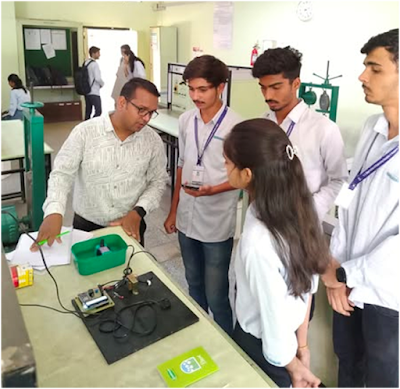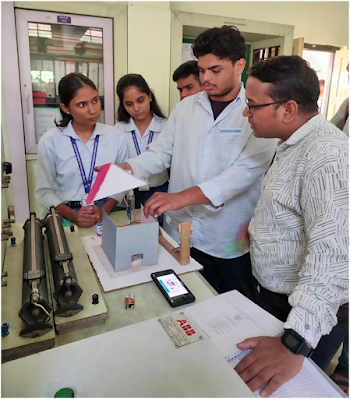HOD Corner
It gives me
immense pleasure to present to you the June 2025 edition of our departmental
newsletter. This issue captures the vibrant academic culture and the spirit of
innovation that our department continues to nurture among students and faculty
alike.
This month
witnessed a range of impactful events, from the First-Year Project Competition
that highlighted creativity and teamwork to student
achievements in institute-level competitions and notable placement successes. I
extend my heartfelt congratulations to all the students for their commendable
performances and express deep appreciation to the faculty mentors who have guided
them.
We also took a
moment to honor the most silent yet powerful contributors to our students’
journeys, their parents. Through our “Honoring Parental Support” initiative,
we celebrated the vital role families play in shaping the future of our learners.
As we continue
this journey, I urge our students to remain curious, grounded, and ethically
driven in their pursuits. Let us collectively work towards academic excellence,
innovation, and social responsibility.
Department Events
First-Year Project Competition Showcases Innovation and Teamwork – 2nd June 2025
The Department
of Electrical Engineering successfully conducted the First-Year Project
Competition under the Engineering Exploration course on 2nd June 2025. 💡
🎯 Around
30 student groups showcased their creativity and engineering skills through
innovative project models and solutions. It was truly inspiring to witness such
enthusiasm and a problem-solving mindset at the very beginning of their
engineering journey!
🧑⚖️ The projects were meticulously evaluated by
experts Dr. Neeleshkumar Gupta and Dr. Anand Kumar, whose valuable feedback
added great learning value to the event.
🎯 The
entire competition was efficiently coordinated by Prof. J. D. Patil and Prof.
A. S. Khaire, who ensured smooth execution and meaningful student
engagement.
Student Corner
Student Placement
The following
students are placed in various multinational companies. Congratulations to all
the students!
Placed Students Details (June 2025)
|
Sr. No. |
Name of the Student |
Package |
Placement Date |
| 1. |
Jyoti
Prabhakar Waje |
4 |
12/06/2025 |
|
2. |
Karan
Ashok Gaikwad |
4 |
12/06/2025 |
|
3. |
Prathmesh
Umesh Chaudhari |
4 |
12/06/2025 |
|
4. |
Pravin
Shivnath Khalkar |
4 |
12/06/2025 |
|
5. |
Shradha
Kisan Avhad |
4 |
12/06/2025 |
|
6. |
Kakade
Akshay Narayan |
3.4 |
30/06/2025 |
|
7. |
Rohan
Rajendra Chaudhari |
3 |
30/06/2025 |
|
8. |
Sakshi
Bhimraj Gorane |
3 |
30/06/2025 |
|
9. |
Saurav
Arun Patil |
3 |
30/06/2025 |
Honoring Parental Support: Felicitation of Mr. Chandrakant Patil’s Parents!
We are proud to felicitate the parents of our
student Mr. Chandrakant Patil, for his remarkable achievement of
securing placement in a prestigious multinational company. Behind every success
story stands unwavering parental support, encouragement, and sacrifice.
This felicitation is a tribute to their
dedication and belief in their child’s potential. Congratulations to
Chandrakant and his proud parents! Wishing him continued success in his
professional journey ahead.
Honoring Parental Support: Felicitation of Mr. Tushar Kangne’s Parents!
We are proud
to felicitate the parents of our student.
Tushar Kangne, for his remarkable achievement of securing placement in a
prestigious multinational company. Behind every success story stands unwavering
parental support, encouragement, and sacrifice.
This
felicitation is a tribute to their dedication and belief in their child’s
potential. Congratulations to Tushar and his proud parents! Wishing him
continued success in his professional journey ahead.
Honoring Parental Support: Felicitation of Mr. Avishkar Arote’s Parents!
We are proud
to felicitate the parents of our student.
Avishkar Arote, for his remarkable achievement of securing placement in a
prestigious multinational company. Behind every success story stands unwavering
parental support, encouragement, and sacrifice.
This
felicitation is a tribute to their dedication and belief in their child’s
potential. Congratulations to Avishkar and his proud parents! Wishing him
continued success in his professional journey ahead.
🎉
Congratulations to our Final Year Students!
We are proud to share that
our final-year students — Shreyas Bhadane, Akshay Gawade, Rohan Chaudhari,
Roshan Anwat, Vaibhav Mhaske, Nilesh Sanap, Shraddha Sanap, and Pratiksha
Taskar — have received the Consolation Prize in the Final Year Project Competition
organized by the Internal Quality Assurance Cell (IQAC) of the institute on 3rd
June 2025.
🛠️ Project Title: Development of Electric Agricultural Rover
for Smart Farming Applications
🌱 This innovative project
aims to support smart farming through an electric rover designed for
agricultural use — a great step toward sustainable and tech-driven agriculture!
👏 The team was expertly
guided by Prof. Nayana Jangle and Prof. Sudhir Shinde. We appreciate
their mentorship and encouragement throughout the project journey.
FY BTech (Div N) Students Win 2nd Prize at Project Competition – Showcasing Innovation with Social Impact
Students from
FY BTech (Div N) of the Electrical Engineering Department secured the 2nd Prize
Their
innovative project titled "Smart System / Wristband for Tracking and
Safety at Kumbh Mela" demonstrated creativity, social impact, and
practical application of technology at scale.
Kadam Sumit Prakash
Phokane Harshita Ajay
Rahane Kashish Yogesh
Ushir Tanuja Kailas
Bhalerao Sidharth Rajendra
Your work
truly reflects the spirit of innovation and societal contribution nurtured at
AICTE IDEA Lab.
Faculty Corner
Student Article
BATTERY COOLING SYSTEM FOR ELECTRIC VEHICLES
Abstract
The safety of lithium-ion batteries in vehicles is a priority for the
automotive industry. The focus of the development activities is the reduction
of risks and the improvement of the safety concepts and systems. Constant
monitoring of battery parameters such as temperature, gas level, and voltage,
current will alert the system to any abnormal or worse condition of emergency.
As these conditions may lead to battery fire or battery explosion, early
indication of such activities becomes very important. In a practical case fire
or any accidental impact on the battery may cause an internal short circuit of
the battery, which leads to excessive overheating of the battery, which leads
to an explosion and fire. Our smart sensor-based network will keep batteries
continuously monitoring, and in case of emergency, quickly battery will be
taken out automatically through the stepper-based locks. This system will be
extremely beneficial for saving the valuable life of the driver and the valuable
investment in the vehicle.
1. Introduction:
An electric
vehicle battery (EVB), also known as a traction battery, powers the electric
motors of battery electric vehicles (BEVs) and hybrid electric vehicles (HEVs).
These rechargeable batteries, typically lithium-ion, are designed for high
capacity, with a focus on power-to-weight ratio, specific energy, and energy
density to improve vehicle performance. Unlike starting, lighting, and ignition
(SLI) batteries, EVBs are deep-cycle batteries intended to provide power over
long durations. While current battery technologies have lower specific energy compared
to liquid fuels, they continue to evolve, driven by advances in portable
electronics. Lithium-ion and lithium polymer batteries are most common due to
their high energy density. Battery packs are a significant cost in EVs, but
their prices have decreased by 87% since 2010, making long-range electric
vehicles like the Tesla Model S commercially available. EVs are also much more
energy-efficient than vehicles with internal combustion engines, reducing
operating costs.
2. Problem Identification
The primary problem
with electric vehicle (EV) batteries lies in their relatively low specific
energy and energy density compared to liquid fuels, which limits the maximum
all-electric range of EVs. While lithium-ion batteries, the most common type in
modern EVs, offer high energy density and improved performance due to
advancements in technology, their high cost remains a significant challenge, as
the battery pack constitutes a major portion of the vehicle’s total cost.
Additionally, the weight and size of batteries need to be minimized to enhance
vehicle performance, posing a technical constraint. Despite their efficiency
and reduced operating costs compared to internal combustion engines, further
innovation is needed to address these limitations and make EVs more accessible
and practical for widespread use.
3. System Overview
The Battery Cooling System for
Electric Vehicle diagram is shown in Fig. 1.
Fig 1. Circuit diagram of the Battery cooling
system for an Electric Vehicle
1. Gas Sensor (MQ-8): Detects the presence of flammable gas in the environment and
outputs an analog signal proportional to the gas concentration.
2. Arduino Nano: The microcontroller processes the sensor data. Based on the
threshold set in the program, it activates corresponding components (e.g.,
buzzer, relays).
3.
SIM Module (SIM1): Sends alert messages (SMS) or calls when a gas leak
is detected.
4. Buzzer (BUZ1): Provides an audible alarm when a gas leak is detected.
5. Relays (RL1, RL2): Controlled by the Arduino via transistors (Q1 and Q2). They can
switch on/off external appliances or safety devices (e.g., exhaust fans).
6. Diodes (D2, D3): Protect the transistors and relays from back-EMF generated when
the relays are switched off.
7. LCD Display (LCD1): Displays the system status, such as gas
concentration or warnings.
8. Temperature Sensor (MAX6675 + Thermocouple TC1): Monitors the ambient
temperature and provides data to the Arduino for additional safety monitoring.
9. Power Supply: Batteries (BAT1 and BAT2) provide power to the system, regulated
and protected using diodes (e.g., D1).
4. The need fora battery cooling system for electric vehicles
The need for electric vehicle batteries (EVBs) arises from the
growing demand for sustainable and energy-efficient transportation solutions to
reduce reliance on fossil fuels and decrease greenhouse gas emissions. These
batteries must offer high energy density, specific energy, and power-to-weight
ratios to maximize vehicle range, performance, and efficiency while minimizing
weight and cost. Advances in rechargeable battery technologies, particularly
lithium-ion, are critical to meeting these needs by improving energy storage
capacity, reducing costs, and enabling frequent charging and discharging cycles
without compromising performance. This is essential for the widespread adoption
of battery electric vehicles (BEVs) and hybrid electric vehicles (HEVs) across
various segments of the automotive market.
5. Result
The Battery cooling system for electric vehicles
hardware circuit is shown in Fig. 2.
Fig 2.
Project photo of the Battery cooling system for electric vehicles
Electric vehicle batteries
(EVBs), typically lithium-ion, power electric and hybrid vehicles by providing
sustained energy. They are designed for high capacity, lightweight, and
efficient performance, although their energy density is lower than liquid
fuels, limiting electric range. Advances in battery technology, driven by
demands in portable electronics, have improved their performance and cost. As
of 2019, the cost of EV batteries dropped significantly, making BEVs more
affordable. Despite lower operating costs, battery packs remain a significant
expense in EVs. Energy density, or energy per unit volume or mass, is key to
improving vehicle range and efficiency.
6. Conclusion
Advanced battery cooling systems are crucial to the evolution of electric vehicle (EV) technology, enhancing performance, longevity, and sustainability. By effectively regulating battery temperatures, these systems improve energy efficiency, extend driving range, and reduce range anxiety, thus supporting EV adoption and global sustainability goals. They preserve battery health, minimize degradation, and reduce waste, increasing economic and environmental viability. Innovations in cooling technologies, including smart and adaptive systems powered by data analytics and machine learning, optimize energy usage and battery lifespan. This holistic approach ensures scalable, cost-effective, and environmentally friendly solutions, driving cleaner transportation and climate change mitigation efforts.
7. Future Scope
1. A more reliable and safety-ensuring system for safety
while using electric vehicles.
2. Automatic and trouble-free operation, which should not
disturb the normal operation of the vehicle.
3. Smart safety systems should not get damaged, and its
internal faults should be minimal.
4. The future scope for a project on a battery cooling system
for electric vehicles includes enhancing cooling efficiency through advanced
materials and designs, integrating smart sensors for real-time monitoring and
optimization, and developing innovative thermal management strategies to extend
battery lifespan and enhance overall vehicle performance.
5. Additionally, exploring sustainable and eco-friendly
cooling solutions to minimize environmental impact will be crucial.




























